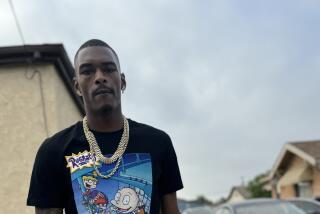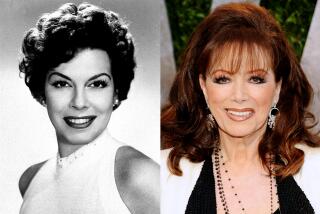When the Editor Is Sassy : Jane Pratt, editor of an upstart magazine for teen-agers--and anyone else who thinks young--is 29, going on 16. ‘I’m not just talking about young people. I am one.’
- Share via
Forgive Jane Pratt for jiggling in her chair. Forgive the girlish squeal that sneaks into her voice. At 29, Pratt is finally queen of the prom.
“Now I’m the popular kid I wasn’t when I was 16,” she coos, relieved at having survived the awkwardness and embarrassments that pain so many teen-agers. “I was miserable then.”
Now she is editor-in-chief--which sounds entirely too grown-up--of her own magazine. Sassy is sort of a flip version of Seventeen, and it’s unmistakably Jane, with page upon page of helter-skelter photographs and cosmetic ads. With articles that are chatty and gossipy and occasionally urgent.
Now she has her own TV talk show--an “Oprah Winfrey with zits,” she says. A recent test run of “Jane” on an independent New York station drew strong ratings, so several networks are bidding to air the show nationwide. She might get to gossip with a whole country of girlfriends.
And now she pals around with Quincy Jones and gets interviewed by Maria Shriver. Her best friend is R.E.M.’s Michael Stipe. She danced in the band’s “Shiny Happy People” video on MTV.
“It’s a dream,” she says, twisting that thin body of hers, crinkling that freckled face. At 29, Pratt has finally grabbed hold of what she always wanted: the perfect teen existence.
Teen-agers everywhere. With millions of them buying Levis and Doritos and lipstick, it’s profitable to specialize in youth. Not that Pratt yearns for wealth, but it’s nice to be in demand.
As if a magazine and talk show weren’t enough, she consults for Dirt magazine--Sassy’s male alter ego--and for Quincy Jones’ new hip-hop monthly called Vibe. Jones offered her the editor’s job, but her dance card was full.
“The French call it branche --which means electrically connected,” Jones says. “Jane’s smart. She’s aware. She’s good.”
All this because she showed up at an interview in New York City wearing Salvation Army chic. It was 1988 and John Fairfax Ltd., an Australian media conglomerate, was looking for someone to head its new American teen magazine. Pratt had worked as a paid intern at McCall’s and as an associate editor at the late Teenage Magazine. Other applicants brought better resumes, but she brought the right attitude.
Attitude. From the very start, Sassy has fought the notion that girls should be good or polite or even have boyfriends if they don’t want to. In other words, Sassy contradicts the tradition of teen magazines.
And that bothers some people.
“I’ve got two teen-agers in my family,” says Elizabeth Crow, the editorial director of Y M magazine, a competitor. “I read Sassy before they do because I worry that it has a very dark view of the world that isn’t always warranted.”
Abortion, the death penalty, premarital sex--Sassy pursues topics that teen magazines often avoid. And discussing hefty matters in teen lingo can be tricky.
The Persian Gulf War inspired an analysis titled “The Iraq Thing,” with subheads like “Why George Got Peeved” and “What Saddam is Irked About.” Profiling a teen on Indiana’s Death Row, the writer described entering prison and fretting that her under-wire bra might set off a metal detector.
“More sissy than sassy,” wrote L.A. Times reviewer John Gabree. He suggested that such articles reduce “life-and-death matters to the level of squibs on fashion and grooming.”
Pratt spins into a curious bit of self-fulfilling logic when she hears this. “That’s an adult viewpoint, and this magazine isn’t for adults,” she says. “If we wrote in the style of the Wall Street Journal, our readers wouldn’t touch us.”
As Stipe told Media Week: “She’s smart like an adult, but smarter like a kid.”
So the bylines in her magazine often read by first name--”Noel” or “Andrea L.”--because Sassy wants to be chummy. Margie the movie critic pans “Sarafina!” by labeling it “dorky--as in big cheeseball production numbers.” Christina offers 11 uses for an ex-boyfriend (No. 3: “As a focus for all your longing, bitterness and hatred.”)
The staff is prodded to reveal personal hopes and insecurities. Kim writes about her alcoholic father. Margie scolds the film “Jersey Girl” for its portrayal of a secretary who gets jilted by an executive, then adds: “I’m sorry, I was dumped by an investment banker and I’m still bitter.”
“We’re still getting dumped by boyfriends,” Pratt says. “We still get zits.”
Which brings us back to the inspiration for her work: teen blues. The daughter of hippie parents, she found herself at 16 transported from a progressive school in her hometown of Durham, N.C., to a formal prep school away from home.
“Those kids had a different set of values, and a lot of them were really rich,” she recalls. “The first year, I had maybe two friends. I spent a lot of time alone and very, very, very depressed.”
Teen magazines were “like a lifeline,” she says. “When you’re feeling alone with a problem, a magazine talking about that problem can make you feel more connected.” Now, she has the chance to provide the same comfort to her readers.
“They can think, ‘If Jane wasn’t popular when she was 16, then I’ll be OK too,’ ” she says.
Schoolgirls who drop by Sassy’s headquarters are ushered into the editor’s office. They talk about what’s cool and what’s not. Pratt knows this stuff because she does a lot of the same things her readers do: She shops, goes to movies, checks out new bands at CBGB. Prince is not a phenomenon to be researched; he’s the singer she puts on her answering machine at home.
“I doubt you’d see the editor of Seventeen at Lollapalooza,” she says.
Her mix of contumacy and intimacy works. Sassy burst out of the gates in 1988 with a paid circulation of 250,000. That figure has risen to 715,000 in four years time. Seventeen, with its 2 million readers, isn’t exactly terrified. But competitors can’t ignore the new girl in class.
“Sassy is a magazine with some zip,” Crow says, if somewhat grudgingly.
So maybe a keen edge lies hidden beneath Pratt’s burbling persona, a shark’s instinct that has helped her gobble success. Maybe she masks it with the soft crinkle of her eyes and covers it with old, flowery dresses.
“I’m not, like, high-powered,” she argues. Again, she dismisses her success in innocent terms: “I’m not just talking about young people. I am one.”
Between working and club-hopping, there isn’t time for much else. When Pratt gets a few free hours, she’ll read a trashy crime book in her apartment in the Village. “I never cook,” she says. “I live above a Mexican restaurant, and I make them deliver up to me because, in a way, I’m lazy.”
A current visit to Los Angeles has afforded a chance to drive, which she never does in New York, and to hang out with Stipe, who has been in town. Three silver rings--a gift from him--hang from a tatty green ribbon around her neck.
The story of their meeting is worthy of a bad romance novel. Few people had heard of R.E.M. back then, when Pratt was just a sophomore at Oberlin College. She saw the band in Cincinnati and, after the concert, chased their van down the street. Stipe opened up only after she banged on the window.
“I’d like to clear up one thing,” she says. “We used to date, but now we’re friends.”
Now, when they hang out, the tabloids hint of love. “We think that’s so funny,” she says. “We were doing these things 10 years ago and no one even cared.”
Now, a lot of people notice Pratt. That’s what happens when you’re popular.
More to Read
The complete guide to home viewing
Get Screen Gab for everything about the TV shows and streaming movies everyone’s talking about.
You may occasionally receive promotional content from the Los Angeles Times.







